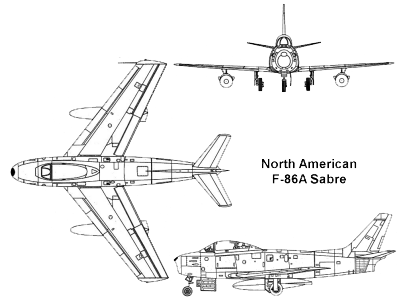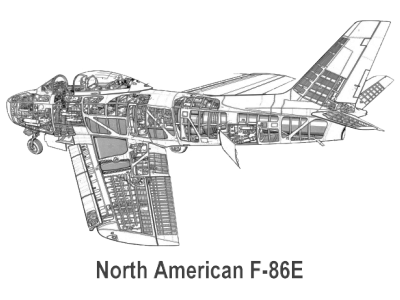The North American F-86 'Sabre' (sometimes called the 'Sabrejet') was a transonic jet fighter aircraft. Produced by North American Aviation, the F-86 Sabre is best known as the United States's first swept wing fighter which could counter the similarly-winged Soviet MiG-15 in high-speed dogfights over the skies of the Korean War. Considered one of the best and most important fighter aircraft in the Korean War, the F-86 is also rated highly in comparison with fighters of other eras.
Development
Designed by Edgar Schmued at North American Aviation, the F-86 Sabre was an evolution of the company's FJ Fury design. Conceived for the US Navy, the Fury possessed a straight wing and first flew in 1946. Initial proposals to meet a United States Army Air Forces (USAAF) requirement for a medium-range, single-seat, high-altitude jet-powered day escort fighter/fighter bomber were drafted in mid-1944. In early 1945, North American Aviation submitted four designs. The USAAF selected one design over the others, and granted North American a contract to build three examples of the XP-86 (eXperimental Pursuit). Crucially, the XP-86 would not be able to meet the required top speed of 600 mph (970 km/h), so North American had to quickly come up with a radical change that could leapfrog it over its rivals. The North American F-86 Sabre was the first American aircraft to take advantage of flight research data seized from the German aerodynamicists at the end of World War II. This data showed that a thin swept wing could greatly reduce drag and delay compressibility problems which plagued aircraft when diving and approaching the sound barrier. Study of the data showed that a swept wing would solve their speed problem, while a slat on the wing's leading edge which extended at low speeds would enhance low-speed stability. Incorporating a swept wing and other changes, Schmued's XP-86 prototype first took to the skies the following year. It made its first flight on October 1, 1947 flown by North American chief test pilot George S. Welch who, in a high speed dive from 35,000 feet, broke the sound barrier(unofficially) 14 days before Chuck Yeager went supersonic(officially) in level flight flying the rocket powered Bell X-1. The first production F-86A-1 for the re-designated United States Air Force (USAF) flew on May 20, 1948. On September 15, 1948, an F-86A set a new world speed record of 670.97 mph. Originally designed as a high-altitude day fighter, the F-86 Sabre would undergo a number of changes during its operational use resulting in 20 different variants (including the US Navy FJ series known as the Fury). Some variants had major differences such as the F-86H designed to be a fighter bomber and the F-86D designed as an all-weather interceptor, thus the 'Sabre' was really a whole family of related aircraft.
Back to Top
These variants represented many firsts in design and technology. The F-86 also employed a hydraulic system for the movement of the flight controls to eliminate the excessive control stick forces necessary for a pilot to maneuver other types of aircraft at high speeds. The F-86D model was the first fighter jet to have an autopilot. The identifying features of the F-86 were its 4.78 aspect-ratio wing with a 35° sweepback and the air inlet located in front of the nose. Stream wise airfoil-section thickness ratios varied from 9.5 percent at the root to 8.5 percent at the tip. Pitch-up was prevented on some models by full-span leading-edge wing slats on the F-86E and F models as on the Me 262. Deployment of the slats was automatically initiated at the correct angle of attack by aerodynamic loads acting at the leading edge of the wing. On later versions of the aircraft the slats were replaced by a sharp extended-chord cambered leading edge. Single-slotted high-lift flaps and outboard ailerons were incorporated in the trailing-edge portions of the wing. The ailerons were hydraulically actuated as was the first horizontal all-flying tail assembly on the F-86E which meant the entire stabilizer could be rotated in conjunction with a linked elevator.
Back to Top
Armaments for the F-86 versions were the six 0.50 in (12.7 mm) M3 Browning machine guns with electrically boosted feed in the nose (later versions of the F-86H carried four 20 mm (0.79 in) cannons instead of machine guns). Firing at a rate of 1,200 rounds per minute, the .50 in (12.7 mm) guns were harmonized to converge at 1,000 ft (300 m) in front of the aircraft. One of the big advantages the F-86 had was the installation of the APG radar gunsight. Initial planes were fitted with the Mark 18 manual-ranging computing gun sight. The last 24 F-86A-5-Nas and F-86E were equipped with the A-1CM gunsight-AN/APG-30 radar which used radar to automatically compute the range of a target. This would later prove to be a significant advantage against MiG opponents over Korea.
Back to Top
In Action
Korea
The F-86 entered service in 1949, with the Strategic Air Command's 22nd Bomb Wing, 1st Fighter Wing, and 1st Fighter Interceptor Wing. In November 1950, the Soviet-built MiG-15 first appeared over the skies of Korea. Vastly superior to every United Nations aircraft then in use in the Korean War, the MiG-15 forced the US Air Force to rush three squadrons of F-86s to Korea. Upon arriving, US pilots achieved a high level of success against the MiG. This was largely due to experience as many of the US pilots were World War II veterans whereas their North Korean and Chinese adversaries were relatively raw. American success was less pronounced when F-86s encountered MiGs flown by Soviet pilots. Early variants of the F-86 could not outturn, but they could outdive the MiG-15, although the MiG-15 was superior to the early F-86 models in ceiling, acceleration, rate of climb and zoom. With the introduction of the F-86F in 1953, the two aircraft were more closely matched, with many combat-experienced pilots claiming a marginal superiority for the F-86F. MiG-15s flown from bases in Manchuria by Red Chinese, North Korean, and Soviet VVS pilots were pitted against two squadrons of the 4th Fighter-Interceptor Wing forward-based at K-14, Kimpo, Korea. Due to operational requirements, more replacements were required, so the conversion of the 51st Fighter-Interceptor Wing from the F-80 to the F-86 was made in December 1951. Two more fighter-bomber wings, the 8th and 18th, converted to the F-86F in the spring of 1953. No. 2 Squadron, South African Air Force also distinguished itself flying F-86s in Korea as part of the 18 FBW. The MiG-15 pilots were good, being (for the most part) World War Two veteran Russian fliers, however, many of the Sabre pilots were also veterans of World War Two and their expertise showed.
Back to Top
On December 17, 1950, Lt. Colonel Bruce H. Hinton scored the first MiG-15 kill by a Sabre pilot. On May 20, 1951 Captain James Jabara became the worlds first (Sabre) jet ace. 'MiG Alley' remained a hot spot throughout the conflict. Day after day F-86s swept into MiG Alley to meet MiGs which were based at airfields located in Manchuria just across the Korean border along the Yalu River. Although the United Nations had directed that the Manchurian airfields were "off limits" to USAF aircraft, some (aggressive) F-86A pilots occasionally strayed into that sanctuary while in hot pursuit of prey. Of the 40 USAF pilots to earn the designation title of 'ace' (five or more kills) 39 flew the Sabre, and by the end of the war (July 27, 1953) no fighter in the world could take on an F-86 without being at a disadvantage. By the end of hostilities, F-86 pilots were credited with shooting down 792 MiGs for a loss of only 78 Sabres, a victory ratio of 10:1. More recent research by Dorr, Lake and Thompson has claimed the actual ratio is closer to 2:1. The Soviets claimed to have downed over 600 Sabres, together with the Chinese claims, although these are thought by some to be an overcount as they cannot be reconciled with the 78 Sabres recorded as lost by the USAF.
Back to Top
1958 Taiwan Strait Crisis
The Republic of China(ROC) Air Force of Taiwan was an early recipient of surplus USAF Sabres. From December 1954 to June 1956, the ROC Air Force received 160 ex-USAF F-86F-1-NA through F-86F-30-NA fighters. By June 1958, the Nationalist Chinese had built up an impressive fighter force, with 320 F-86Fs and seven RF-86Fs having been delivered. Sabres and MiGs were shortly to battle each other in the skies of Asia once again in the Second Taiwan Strait Crisis. In August 1958, the Chinese Communists of the People's Republic of China attempted to force the Nationalists off of the islands of Quemoy and Matsu by shelling and blockade. Nationalist F-86Fs flying CAP over the islands found themselves confronted by Communist MiG-15s and MiG-17s, and there were numerous dogfights. During these battles, the Nationalist Sabres introduced a new element into aerial warfare. Under a secret effort designated Operation Black Magic, the U.S. Navy had provided the ROC with the AIM-9 Sidewinder, its first infrared-homing air-to-air missile, which was just entering service with the United States. The combat introduction of the Sidewinder took place in a battle on 24 September 1958 when ROC Sabres succeeded in destroying 10 MiGs and scoring two probables without loss to themselves. In one month of air battles over Quemoy and Matsu, Nationalist pilots tallied a score of no less than 31 MiGs destroyed and eight probables, against a loss of two F-84Gs and no Sabres.
Back to Top
Indo-Pakistani Wars 1965 & 1971
In 1954, Pakistan began receiving the first of a total of 120 F-86F Sabres. Many of these aircraft were the F-86F-35 from USAF stocks, but some were from the later F-86F-40-NA production block, made specifically for export. In the air-to-air combat of the Indo-Pakistani War of 1965, the PAF Sabres claimed to have shot down 15 IAF aircraft, comprising nine Hunters, four Vampires and two Gnats. India, however, admitted a loss of 14 combat aircraft to the PAF's F-86s. The F-86s of the PAF had the advantage of being armed with AIM-9B/GAR-8 Sidewinder missiles whereas none of its Indian adversaries had this capability. Despite this, the IAF claimed to have shot down four PAF Sabres in air-to-air combat. This claim is disputed by the PAF who admit to having lost seven F-86 Sabres during the whole 23 days but only three of them during air-to-air battles. In the 1971 war, the PAF F-86s performed well with Pakistani claims of downing 31 Indian aircraft in air-to-air combat. These included 17 Hawker Hunters, eight Sukhoi Su-7 "Fitters", one MiG 21 and three Gnats while losing seven F-86s.
Back to Top
CAC Sabre
Under license, production lines for F-86 Sabre day fighters were established in four foreign countries, Canada, Australia, Japan, and Italy. During the years 1947 through 1961, before production ended, a total of 8,745 were manufactured with five different engines making it the most prolific jet fighter ever produced. Of the total, 6297 were built in the U. S. and 1815 in Canada. The Canadair Sabre also significantly redesigned the F-86 to the CAC Sabre (sometimes known as the Avon Sabre or CAC CA-27), which had a production run of 112. The CAC Sabres included a 60% fuselage redesign, to accommodate the Rolls-Royce Avon Mk 26 engine, which had roughly 50% more thrust than the J47, as well as 30 mm Aden cannons and AIM-9 Sidewinder missiles. As a consequence of its powerplant, the Australian-built Sabres are commonly referred to as the 'Avon Sabre'. The last Sabre to be produced rolled off the Mitsubishi of Japan assembly line in 1961. Its success led to an extended production run of more than 7,800 aircraft between 1949 and 1956, in the United States, Japan and Italy. The Sabre was by far the most-produced Western jet fighter, with total production of all variants at 9,860 units.
Back to Top
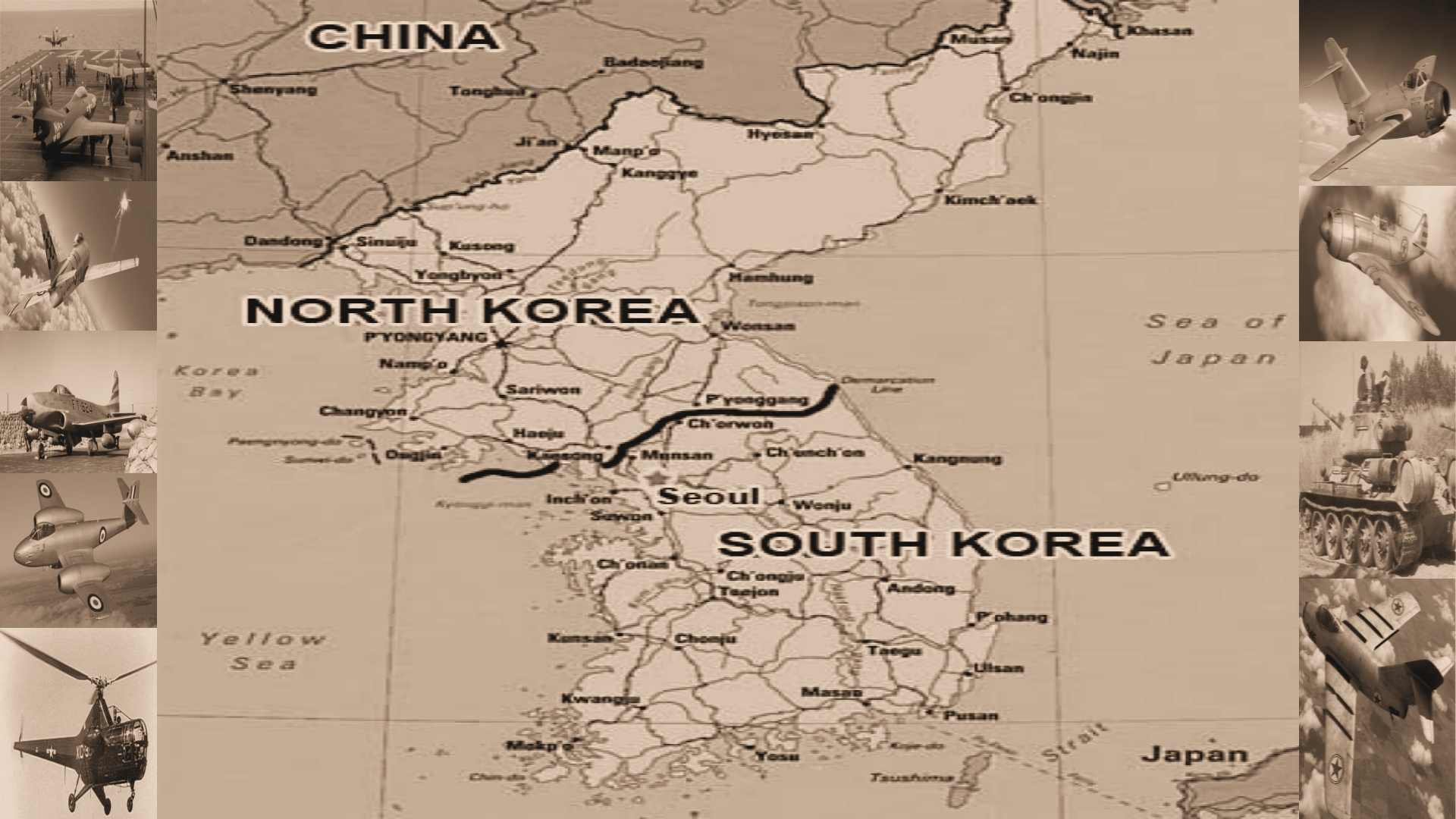

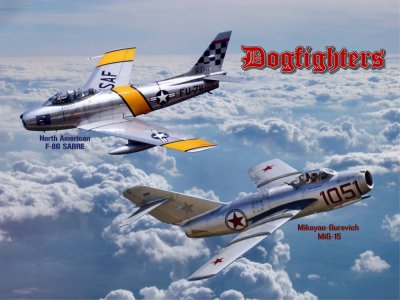
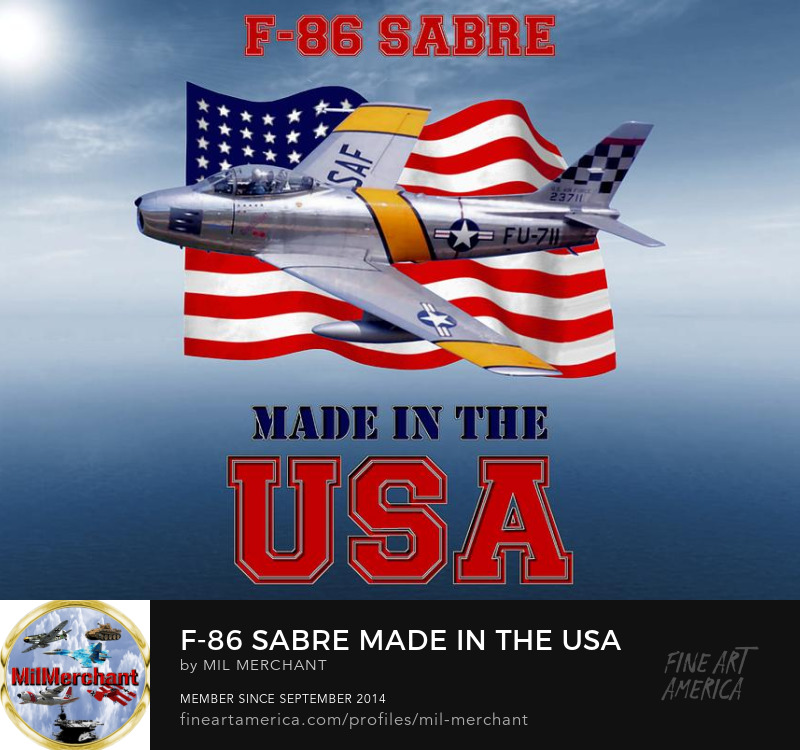

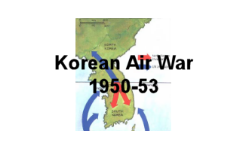 Korean War
Korean War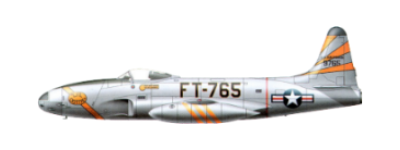 P-80 Shooting Star
P-80 Shooting Star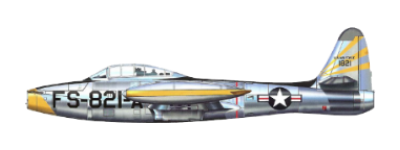 F-84 Thunderjet
F-84 Thunderjet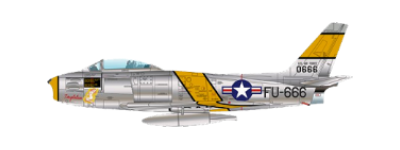 F-86 Sabre
F-86 Sabre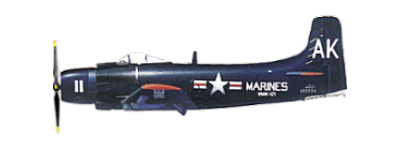 AD1 Skyraider
AD1 Skyraider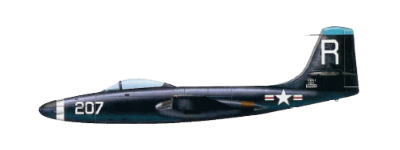 F2H Banshee
F2H Banshee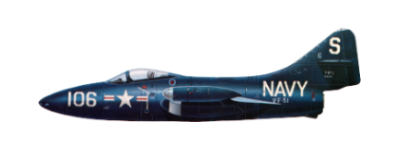 F9F Panther
F9F Panther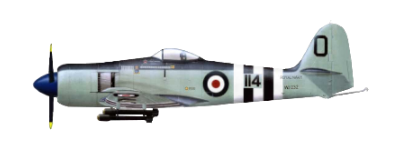 Seafury
Seafury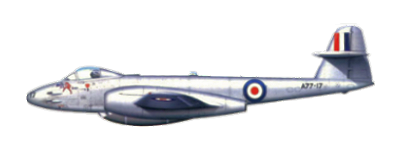 Meteor
Meteor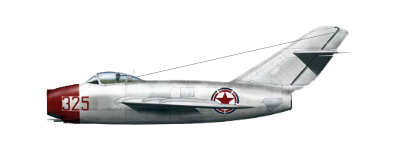 Mig-15
Mig-15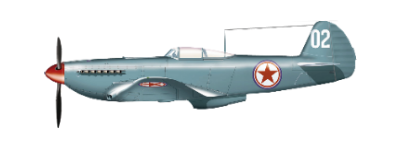 Yak-9
Yak-9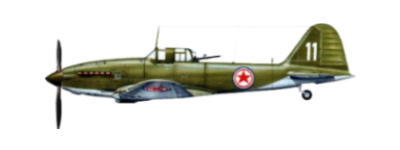 IL-10 Shturmovik
IL-10 Shturmovik
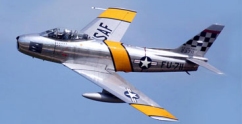

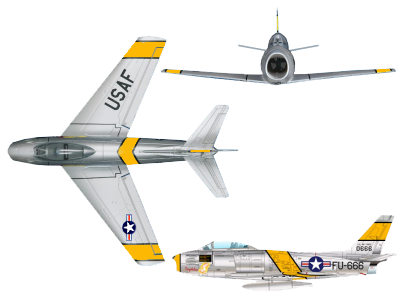
 North American F-86 'Sabre'
North American F-86 'Sabre'